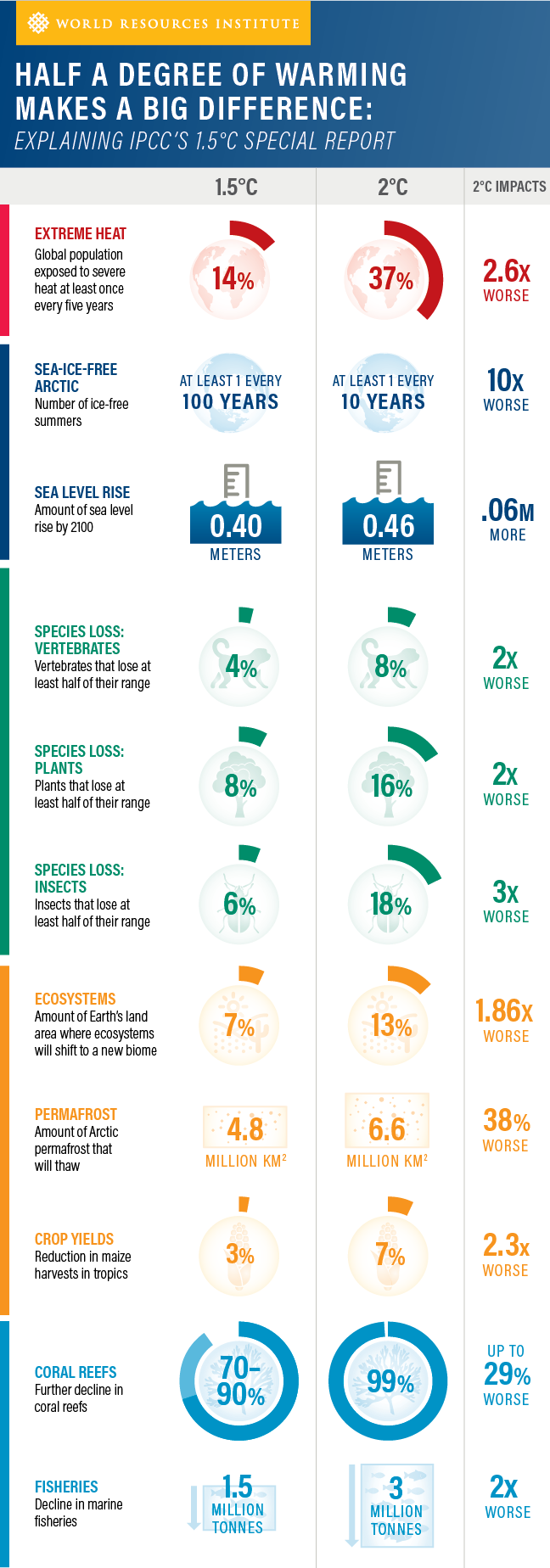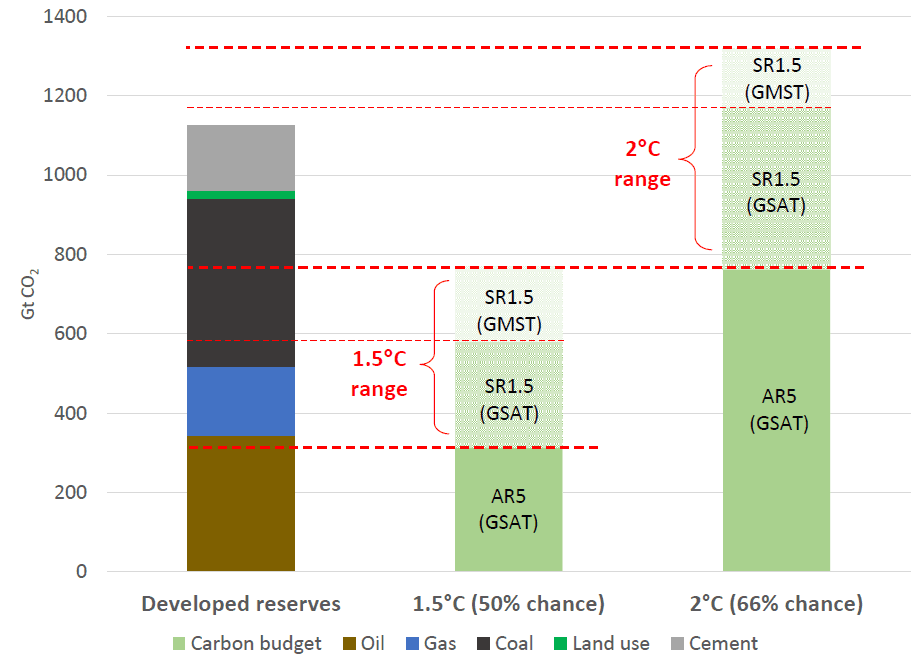Keeping global warming to 1.5 degrees
1.5°C: the bottom line
The science behind fighting runaway global warming and avoiding the worst impacts of climate change is clear – the world cannot build any new or expanded fossil fuel projects, including supply (coal mines and oil & gas reserves) and power plants.
What’s more, large chunks of the world’s fossil fuel reserves cannot be burned and current supply and use of fossil fuels must rapidly decline. Scientific, technical and economic analysis tells us that in order to to keep global temperature rise to no more than 1.5º above pre-industrial levels:
- By 2040, the world must phase-out coal-fired power generation.
- By 2030, OECD and EU28 countries must stop burning coal for electricity.
- At least 88% of global coal reserves must remain unburned.
- Global energy needs supplied by coal must decline by 97% by 2050 (relative to 2010) according to the IPCC.
- Global energy needs supplied by gas must decline by:
- 74% by 2050 (relative to 2010) according to the IPCC; or
- 94% from 2020 (132,241 PJ/a) to 2050 (7,315 PJ/a) according to UTS modelling.
- 6% of gas and 9% of oil production forecast from existing fields is incompatible with 1.5°C.
What companies need to do
Companies must recognise the realities of the rapid decarbonisation required to hold warming to 1.5°C, and immediately act to align their business strategies with these realities.
Financiers and investors must demand this action, and end support for companies that cannot or will not play their part in the transition to a 1.5°C-aligned economy.
Learn more about the action required from:

Keeping global temperature rises to 1.5°C is critical for the survival of coral reefs such as the Great Barrier Reef. The IPCC forecasts that 99% of coral globally is likely to die off at 2°C warming, compared to 70-90% at 1.5°C.

What is 1.5°C? Why is it important?
- According to the Intergovernmental Panel on Climate Change (IPCC), human activity is estimated to have caused 1.0°C of global warming above pre-industrial levels.
- The Paris Agreement, the world’s first legally binding climate change agreement signed in December 2015 by 175 parties representing over 200 countries, has the long-term goal of “holding the increase in global average temperature to well below 2°C above pre-industrial levels and pursuing efforts to limit the temperature increase to 1.5°C above pre-industrial levels.”
- In 2018 the IPCC released its 1.5°C Special Report which reinforced the huge risks of global warming above 1.5°C, leading to widespread calls for greater climate action.
The differences between holding global warming to 1.5ºC as opposed to 2ºC are illustrated in a World Resources Institute infographic (top right).
The benefits of limiting warming to 1.5°C, compared with 2°C, are particularly significant for natural ecosystems and they are also significant for water resources, agriculture, and human health, especially in poorer regions of the world.
How can we achieve 1.5°C?
To limit global warming to 1.5°C, the IPCC says that by 2030 we must cut global emissions 45% on 2010 levels, and reach net zero emissions by 2050.
What does this mean for the fossil fuel industry and its investors?
- No new fossil fuel power stations. According to researchers at Oxford University: “Even if all currently planned projects are immediately suspended, up to 20% of global fossil-fuel generation capacity would still have to be stranded (that is, prematurely decommissioned, underutilised, or subject to costly retrofitting) if humanity is to meet the climate goals set out in the Paris Agreement.”
- Phase out existing coal-fired power stations. Based on analysis of IPCC data, Climate Analytics finds the world must phase out coal power generation by 2040.
- Numerous reports, including those from Climate Analytics and Coalswarm/ Greenpeace, conclude that OECD and EU28 countries must stop burning coal for electricity by 2030. This goal is endorsed by the Powering Past Coal Alliance, a diverse group of 80 member governments, businesses and organisations united in their ambition for rapid phasing out of unabated coal-fired power and in projecting clean growth.
- In December 2018, investors representing US$32 trillion in assets called on global leaders to achieve the Paris Agreement’s goals by taking steps such as phasing out thermal coal power worldwide by set deadlines, including a 2030 deadline for OECD countries like Australia.
- Numerous reports, including those from Climate Analytics and Coalswarm/ Greenpeace, conclude that OECD and EU28 countries must stop burning coal for electricity by 2030. This goal is endorsed by the Powering Past Coal Alliance, a diverse group of 80 member governments, businesses and organisations united in their ambition for rapid phasing out of unabated coal-fired power and in projecting clean growth.
- According to scenario modelling by UTS researchers, “In the 1.5°C Scenario, the phase-out of coal and lignite power plants is accelerated, and a total capacity of 618 GW—equivalent to approximately 515 power stations (1.2 GW on average) — must end operation by 2025.” This represents 31% of global installed coal-fired power capacity.
- Declining gas use. Under IPCC scenarios for 1.5°C, the role of gas for primary energy must decline globally by 25% by 2030 (from a 2010 baseline).
Take action!
Tell your bank to stop funding fossil fuels
No new or expanded coal, oil or gas supply projects
The total emissions from developed fossil fuel reserves already vastly exceed the carbon budget for 1.5°C.
- According to the latest IPCC analysis, the remaining global carbon budget (from 2018 onward) for a 66% chance of limiting warming to 1.5°C is 420 Gt CO2.
- Drawing on data from Rystad Energy, the IEA, the World Energy Council and the IPCC – Oil Change International (OCI) provides a visual representation below of the CO2 emissions embedded in developed* fossil fuel reserves, relative to the 1.5°C budget.
- Given that the 942 Gt CO2 embedded in existing and under-construction fossil fuel projects is more than double the IPCC’s 1.5°C budget of 420 Gt CO2, it is absolutely clear there’s no room for new or expansionary fossil fuel supply projects.

*Developed reserves are those that can “be extracted from oil fields, gas fields and coal mines that are already operating – for which the wells have been drilled and the pits dug, and where the pipelines, processing facilities, railways, and export terminals have been constructed.”
An April 2019 Global Witness report confirmed this view, finding:
- any production from new oil and gas fields, beyond those already in production or development, is incompatible with limiting warming to 1.5°C
- all of the $4.9 trillion forecast capex in new oil and gas fields is incompatible with limiting warming to 1.5°C
- 9% of oil and 6% of gas production forecast from existing fields is incompatible with limiting warming to 1.5°C
Phase out of coal, oil and gas supply
- Coal
The IPCC models global energy needs (‘primary energy’) supplied by coal declining by 78% by 2030 and by 97% by 2050 (from a 2010 baseline) under a 1.5°C scenario.
The University of Technology Sydney (UTS) ‘One Earth Climate Model‘ under a 1.5°C scenario sees lignite production falling to zero by 2040, while production of ‘hard coal’ declines 92% from 2020-2050 – from 5,226 million tonnes per annum (mtpa) in 2020, to 1,723 mtpa in 2030, reaching 407 mtpa in 2050.
According to a letter published in one of the world’s top academic journals Nature, researchers at University College London found that ~90% of the world’s coal reserves must remain unburned for a 50% chance of limiting warming to 2°C. A 66% chance of limiting warming to 1.5°C would require that an even greater proportion remain unburned.
Limiting warming to 1.5°C would require an extremely rapid transition in the coal sector.
- Gas
The IPCC models global energy needs (‘primary energy’) supplied by gas declining by 25% by 2030 and by 74% by 2050 (from a 2010 baseline) under a 1.5°C scenario.
The UTS One Earth Climate Model projects a decline in gas production of 21% from 2020 (132,241 PJ/a) to 2030 (104,349 PJ/a), and a 93% decline from 2030 to 2050 (7,315 PJ/a). This represents an overall decline of 94% from 2020 to 2050.
According to Global Witness, 6% of gas production forecast from existing fields is incompatible with 1.5°C.
- Oil
The IPCC models global energy needs (‘primary energy’) supplied by oil declining by 37% by 2030 and by 87% by 2050 (from a 2010 baseline) under a 1.5°C scenario.
The UTS One Earth Climate Model projects a decline in oil production of 58% from 2020 (163,957 PJ/a) to 2030 (68,449 PJ/a), and a 78% decline from 2030 to 2050 (14,794 JP/a). This represents an overall decline of 91% from 2020 to 2050.
According to Global Witness, 9% of oil production forecast from existing fields is incompatible with 1.5°C.
The @IPCC_CH report on #GlobalWarming of 1.5°C is one of the most important #climatechange reports ever published. Limiting temperature increase requires unprecedented changes in society, but will have huge benefits. Every half a degree of warming matters. https://t.co/a7GOzVFv50 pic.twitter.com/p0wX5vYrA5
— IPCC (@IPCC_CH) October 8, 2018
New Nature paper out today https://t.co/oAF7nep6ur
states very clearly what is needed if governments are serious about limiting global heating to 1.5C, as agreed at Paris.Spoiler: No new fossil fuelled infrastructure, anywhere, ever. From now on.
Read thread for details…
— Mark Lynas (@mark_lynas) July 2, 2019
Producing a ton of steel in a blast furnace produces almost as much carbon #emissions as burning a ton of coal. Until the mining industry tackles that, its green makeover will fail to convince https://t.co/Q8vaGqWDry via @bopinion
— David Fickling (@davidfickling) March 13, 2019
How can anyone with the depth of knowledge of @IEABirol refer to the fastest expansion of natural gas ever as a "golden year". NG is now driving the fastest rise in climate greenhouse warming in history, with 1.5°C on the cards by 2030. That's nothing short of a global disaster. https://t.co/7GzUSkLppg
— Prof Nick Cowern (@NickCowern) March 26, 2019
International Energy Agency challenged for ignoring 1.5°C
According to Oil Change International, in a post dated 8 April 2019:
Last week, some 50 leading scientists, investors, politicians and energy experts wrote to the International Energy Agency (IEA) to make a critical ask: develop a truly Paris-aligned, 1.5 degrees Celsius scenario (with a precautionary approach to Negative Emissions Technologies) and put it at the heart of their annual flagship World Energy Outlook (WEO).
The letter was fundamentally important, because in energy circles, the scenarios developed by the IEA for the WEO are seen as the ”Gold Standard” in helping dictate both political and financial energy decision-making.
At present, the IEA’s forecasts are fundamentally flawed, as they put the world on course for much greater warming than leading climate scientists say is safe.
The letter stated: “we must begin to phase-out fossil fuel production in favour of a rapid scale up of carbon-free energy. Energy information of the kind the IEA has built its legacy upon has the power to fundamentally shape how that journey unfolds.”
“Without the inclusion of a central and realistic 1.5C scenario going forward, the World Energy Outlook would abdicate its responsibility to continue to chart the boundaries of the path of the global energy sector,” the letter concluded.
Campaigners argue that if this 1.5 degree scenario was adopted as a central scenario in the 2019 WEO, it would help shift trillions from fossil fuels to renewables.
IEA’s Sustainable Development Scenario inadequate to achieve Paris Agreement
In its World Energy Outlook (WEO) 2018, the IEA modelled three main future energy scenarios. The IEA claims that one of these, the Sustainable Development Scenario (SDS), would supposedly deliver on the Paris Agreement. This claim has been heavily criticised.
The first and foremost problem with focusing on the SDS is it would not limit warming to 1.5°C. Beyond that, there are serious concerns about its ability to limit warming to even 2°C.
Oil Change International (OCI) and the Institute for Energy Economics and Financial Analysis (IEEFA), jointly critiqued the SDS in detail in the April 2018 report ‘Off Track.’ This report assessed the SDS as detailed in the WEO 2017, although an interim update found that the SDS’ emissions scenario included in WEO 2018 hadn’t changed.
The report concluded the SDS would not deliver on the Paris Agreement:
“Emissions under the IEA’s alternative “Sustainable Development Scenario” (SDS) would exhaust the 1.5-degree Celsius carbon budget by 2023 and the 2-degree budget by 2040.”
IEA warns of $2 trillion in stranded assets.
Our view:
– No new coal needed.
– Oil: $1.4 trillion at risk
– Gas demand to disappoint. pic.twitter.com/NB7KJLuayD— Carbon Tracker (@CarbonBubble) March 26, 2017
In order to move forward we have to know where we are, but we also have to know where we need to go 1.5 Degrees max temp rise. That is the new scenario we expect from @IEA, worlds leading energy modelling institution. Possible! https://t.co/dLZf5CMmiH #GlobalOptimism #FT #WEO2019
— Christiana Figueres (@CFigueres) April 3, 2019
Problems with the SDS include:
- “The SDS has the same emissions profile as the IEA’s Copenhagen-era 450 Scenario (450S), which gives only a 50% chance of keeping warming below 2 degrees Celsius.” By contrast, a variety of models including those from the IPCC, employ a more reasonable 66% probability of reaching particular warming targets.
- “Of the SDS’ recommended upstream oil and gas investment, between 70 and 94% would be surplus to the Paris goals.”
- Despite cautioning in WEO 2017 that bioenergy and CCS technologies “face severe technical, economic and resource constraints,” the 2018 SDS is dependent on these technologies being widely deployed on existing and developing infrastructure. Climate scientists have expressed growing concerns about excessive reliance on negative emissions.
- The WEO only models energy demand and supply to 2040, no further. So why and how are emissions and warming outcomes projected beyond this point?
How can the same emissions lead to a different result in 450S and SDS? The answer is that the IEA has changed its assumption about what happens after 2040, beyond the scope of its own scenarios. This is because warming over the century will be determined by emissions over the century, not just what happens until 2040.
The IEA’s claim that the SDS is aligned with the Paris goals cannot be true unless assuming large-scale deployment of negative emissions technology whose “prospect is remote.”
Top photo credit: Thomas Hafeneth, Unsplashed.com.
